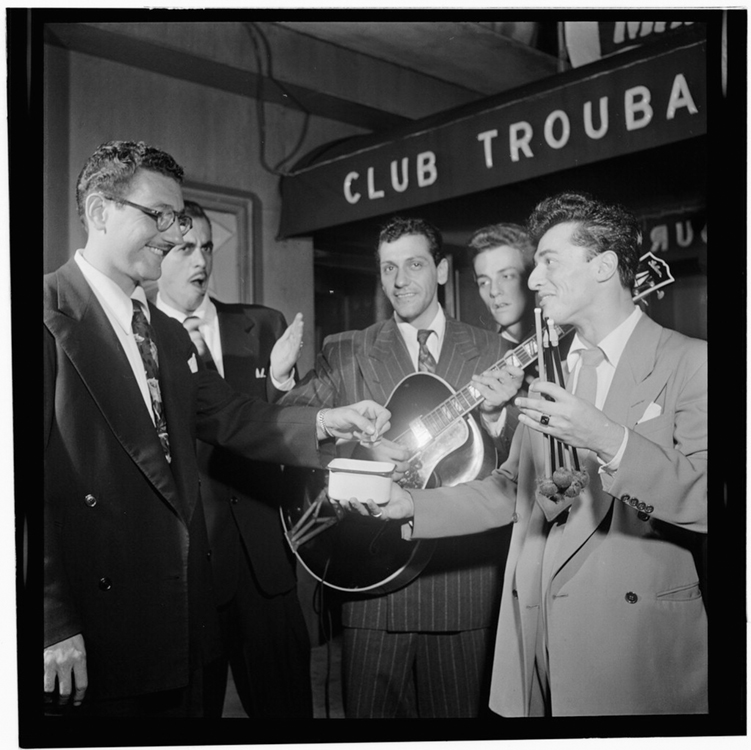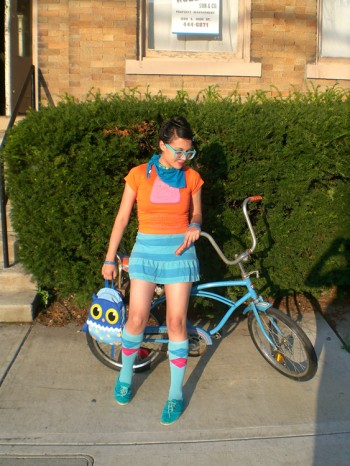Lesson One - Culture
1.3 Pop Culture, Subculture & Cultural Change
Making Connections: Careers
The Evolution of American Hipster Subculture
Skinny jeans, chunky glasses, ironic moustaches, and T-shirts with vintage logos—the hipster is a recognizable figure in contemporary North American culture. Predominantly based in metropolitan areas, hipsters seek to define themselves by a rejection of mainstream norms and fashion styles. As a subculture, hipsters spurn many values and beliefs of North American society, tending to prefer a bohemian lifestyle over one defined by the accumulation of power and wealth.
|
In the 1940s, American hipsters were associated with the “cool” culture of jazz. (Photo courtesy of |
When did hipster subculture begin? While commonly viewed as a recent trend among middle-class youth, the history of the group stretches back to the early decades of the 1900s. In the 1940s, black American jazz music was on the rise in the United States. Musicians were known as “hepcats” and had a smooth, relaxed style that contrasted with more conservative and mainstream expressions of cultural taste. Norman Mailer, in his essay, “The White Negro: Superficial Reflections on the Hipster,” defined those who were “hep” or “hip” as largely white youth living by a jazz-inspired code of resistance, while those who were “square” lived according to society’s rules and conventions.
As hipster attitudes spread and young people were increasingly drawn to alternative music and fashion, attitudes and language derived from the culture of jazz were adopted. Unlike the vernacular of the day, hipster slang was purposefully ambiguous. When hipsters said, “It’s cool, man,” they meant not that everything was good, but that it was the way it was.
Figure 3.8. In the 1940s, American hipsters were associated with the “cool” culture of jazz. (Photo courtesy of William P. Gottlieb/Ira and Leonore S. Gershwin Fund Collection, Music Division, Library of Congress)
By the 1950s, the influence of jazz was winding down and many traits of hepcat culture were becoming mainstream. A new subculture was on the rise. The “Beat Generation,” a title coined by Quebecois-American writer Jack Kerouac, was defined as an age that was nonconformist and anti-materialistic. Prominent in this movement were writers and poets who listened to jazz and embraced radical politics. They bummed around, hitchhiked the country, sought experience, and lived marginally.
College students, questioning the relevance and vitality of the American dream in the face of post-war skepticism, clutched copies of Kerouac’s On the Road, dressed in berets, black turtlenecks, and black-rimmed glasses. Women wore black leotards and grew their hair long. Herb Caen, a San Francisco journalist, used the suffix from Sputnik 1, the Russian satellite that orbited Earth in 1957, to dub the movement’s followers as “beatniks.”
As the Beat Generation faded, a new, related movement began. It too focused on breaking social boundaries, but also advocated freedom of expression, philosophy, and love. It took its name from the generations before; in fact, some theorists claim that the beats themselves coined the term to describe their children. Over time, the “little hipsters” of the 1970s became known simply as “hippies.”
|
Intellectual and trendy, today’s hipsters define themselves through cultural irony. |
Contemporary expressions of the hipster rose out of the hippie movement in the same way that hippies evolved from the beats and beats from hepcats. Although today’s hipster may not seem to have much in common with the jazz-inspired youth of the 1940s, an apparent emphasis on nonconformity persists. The sociologist Mark Greif set about investigating the hipster subculture of the United States and found that much of what tied the group together was not a specific set of fashion or music choices, nor a specific point of contention with the mainstream. What has emerged rather is a culture of consumer capitalism that seeks authenticity in and of itself.
In his New York Times article, “The Hipster in the Mirror” (2010), Greif wrote, “All hipsters play at being the inventors or first adopters of novelties: pride comes from knowing, and deciding, what’s cool in advance of the rest of the world.” And what tends to be cool is an ironic pastiche of borrowed styles or tastes that signify other identities or histories.
Young people are often drawn to oppose mainstream conventions. Much as the hepcats of jazz era opposed common culture with carefully crafted appearances of coolness and relaxation, modern hipsters reject mainstream values with a purposeful apathy. Ironic, cool to the point of non-caring, and intellectual, hipsters continue to embody a subculture, while simultaneously impacting mainstream culture.

